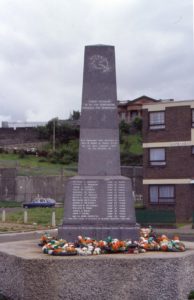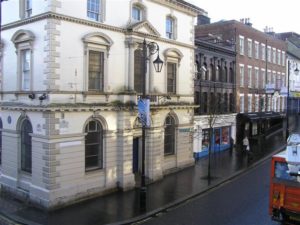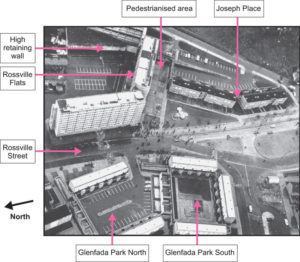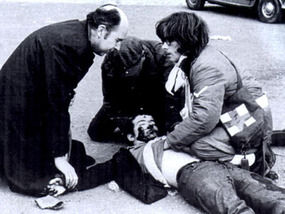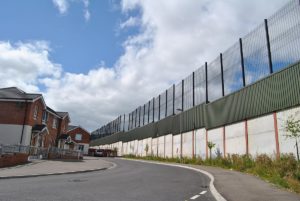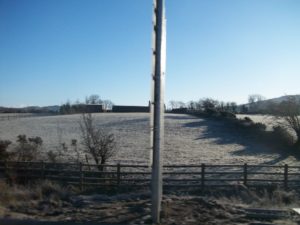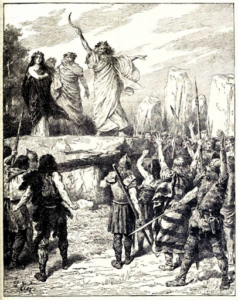Bloom-Cooper, Louis. “Bloody Sunday: Was the NICRA March Illegal or the Ban
on Marches Unlawful?” Political Quarterly, vol. 77, no. 2, Apr. 2006, pp. 227–
237. EBSCOhost, 10 Nov. 2018.
Broderick, Colin. That’s That: A Memoir. Broadway Paperbacks, 2013.
“CIVIL RIGHTS MARCH ATTACKED : DAY 4.” RTE Archives , 1 Apr. 1969,
www.rte.ie/archives/exhibitions/1031-civil-rights-movement-1968-9/1039-peoples- democracy-march-belfast-to-derr/319668-civil-rights-march-attacked-day-4/.
Deutsch, Richard and Gogarty, Frank. “The Founding of the Northern Ireland Civil
Rights Association and Its Early Action.” Études irlandaises, vol. 12 no. 1, 1987. pp. 143-
156. 5 Nov. 2018.
Devlin, Bernadette. The Price of My Soul. Pan Books, 1973.
Dorney, John. “Democracy in Ireland – A Short History.” The Irish Story, 3 Dec. 2018, www.theirishstory.com/2013/04/08/democracy-in-ireland-a-short-history/#.XAFm5hNKjOQ.
Hennessey, Thomas. A History of Northern Ireland:. New York: St. Martin’s Press, 1999.
Hennessey, Thomas. Northern Ireland: the Origins of the Troubles. Gill & Macmillan, 2005.
Hennessey, Thomas. The Northern Ireland Peace Process: Ending the Troubles? New York: Palgrave, 2001.
Maney, Gregory M. “Transnational Mobilization and Civil Rights in Northern
Ireland.” Social Problems, vol. 47, no. 2, 2000, pp. 153–179. JSTOR, 5 Nov. 2018.
McCaffrey, Lawrence J. “Irish Nationalism and Irish Catholicism: A Study in Cultural Identity.”
Church History, vol. 42, no. 4, 1973, pp. 524–534. JSTOR, JSTOR,
www.jstor.org/stable/3164971.
McKittrick, David, and David McVea. Making Sense of the Troubles. Viking, 2012.
MacKittrick, David, and David MacVea. Making Sense of the Troubles the Story of the Conflict in Northern Ireland. Chicago, IL: New Amsterdam Books, 2002.
Northern Ireland Statistics and Research Agency, www.nisra.gov.uk/.
R. Poole and J. Llewellyn, “The Northern Ireland civil rights movement”, Alpha History,
accessed [10 November 2018], https://alphahistory.com/northernireland/northern-ireland-
civil-rights-movement/.
Melaugh, Martin. “How Much Discrimination Was There Under the Unionist Regime, 1921-1968?” CAIN: Northern Ireland Conflict, Politics, and Society. Information on ‘the Troubles’., CAIN (Conflict Archive on the INternet) Project, cain.ulst.ac.uk/issues/discrimination/whyte.htm.
Salem, Rob. “The Troubles: Northern Ireland in the 1960s and 1970s.” Hindsight, Apr.
2011, p. 18+. Glocat. 5 Nov. 2018.
The Irish Times. “Ian Paisley: ‘Never! Never! Never!’ and Other Notable Quotes.” The Irish
Times, The Irish Times, 12 Sept. 2014, www.irishtimes.com/news/politics/ian-paisley-never-never-never-and-other-notable-quotes-1.1 26880.
White, Timothy Jerome. Lessons from the Northern Ireland Peace Process. Madison, WI: University of Wisconsin Press, 2013.
About Us
Natalie Amidon is a freshman International Relations major, whose individual project was on why most attempts during the Irish peace process failed.
Ciara Farrington is a senior Mathematics major. She individually researched the social and governmental policies that led to the Incident at Burntollet Bridge.
Emilio Garcia is a junior, majoring in English and focused his individual project on the IRA.
Hailey Merry is a junior Childhood Education with a concentration in History who researched the formation of the Northern Ireland Civil Rights Association.
Olivia Schmidt is a freshman Biology and English major, who studied the religious divides in Northern Ireland as they affected political differences.
Link to Main Page


